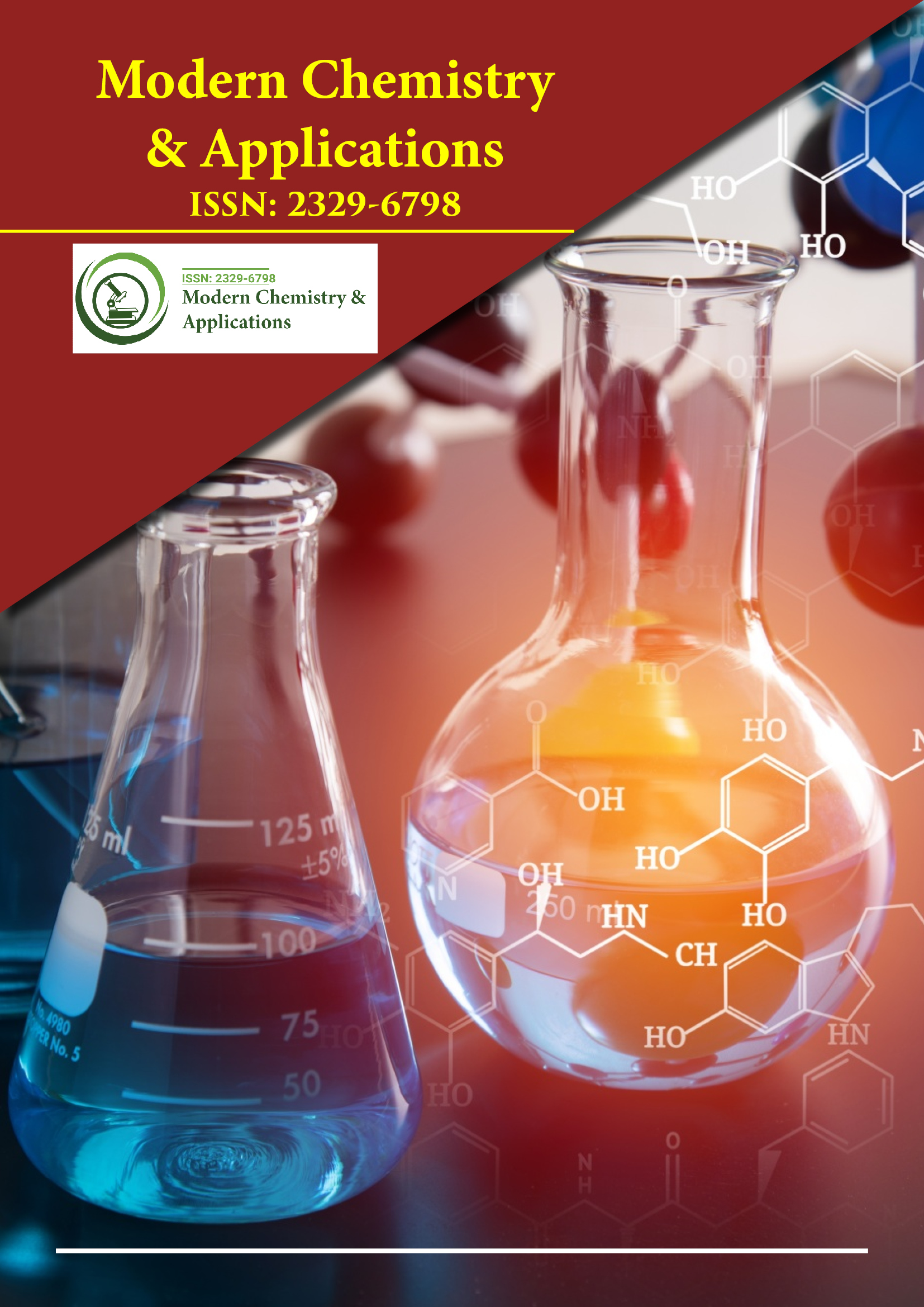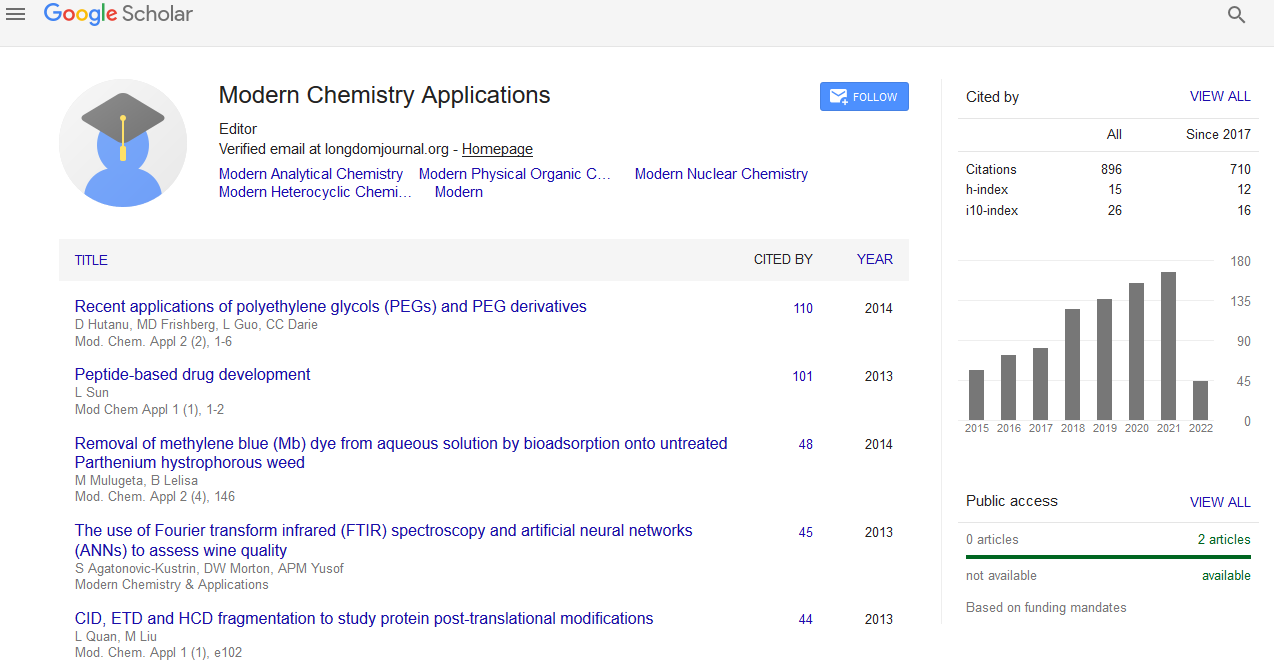Indexed In
- Open J Gate
- JournalTOCs
- RefSeek
- Hamdard University
- EBSCO A-Z
- OCLC- WorldCat
- Scholarsteer
- Publons
- Geneva Foundation for Medical Education and Research
- Google Scholar
Useful Links
Share This Page
Journal Flyer

Open Access Journals
- Agri and Aquaculture
- Biochemistry
- Bioinformatics & Systems Biology
- Business & Management
- Chemistry
- Clinical Sciences
- Engineering
- Food & Nutrition
- General Science
- Genetics & Molecular Biology
- Immunology & Microbiology
- Medical Sciences
- Neuroscience & Psychology
- Nursing & Health Care
- Pharmaceutical Sciences
Perspective - (2024) Volume 12, Issue 2
Coulometric Titration: A Critical Tool for Accurate Environmental Monitoring
Jeong Sang*Received: 01-May-2024, Manuscript No. MCA-24-25209; Editor assigned: 03-May-2024, Pre QC No. MCA-24-25209 (PQ); Reviewed: 17-May-2024, QC No. MCA-24-25209; Revised: 24-May-2024, Manuscript No. MCA-24-25209 (R); Published: 31-May-2024, DOI: 10.35248/ 2329-6798.24.12.460
Description
Coulometric titration is a refined analytical technique that has gained prominence for its precision in quantifying the concentration of an analyte. In Area of acid-base chemistry, modern advancements in coulometric titration have enhanced accuracy, efficiency, and versatility, making it an indispensable tool in various fields. This article explores the latest techniques and innovations involved in acid-base coulometric titrations, highlighting their applications and significance.
The fundamentals of coulometric titration
Coulometric titration is based on the principle of electrochemical generation of the titrant. In an electrochemical cell, the titrant is produced by applying a known current, and the quantity of titrant is directly proportional to the total charge passed through the solution, in accordance with Faraday's laws of electrolysis. The process involves generation of titrant typically a strong acid or base, is generated in situ by an electrochemical reaction. titration reaction generated titrant reacts with the analyte in the solution. End point detection the end point is determined by monitoring a change in a measurable property, such as pH or potential. Quantification the total charge used to generate the titrant is measured and related to the analyte concentration.
Advances in coulometric titration techniques
Modern techniques in coulometric titration have introduced several innovations to enhance accuracy, reduce sample size, and improve ease of use. Key advancements includes. The development of high-precision, stable current sources ensures accurate generation of titrants. Modern current sources can provide highly stable currents, minimizing fluctuations and improving the precision of the titration process. Automation has revolutionized coulometric titration, allowing for highthroughput analysis with minimal human intervention. Automated titrators can control the current, monitor the reaction progress, and determine the end point with high accuracy, increasing efficiency and reproducibility. This technique involves using very small volumes and currents, enabling the analysis of minute sample quantities. Microcoulometry is particularly useful in applications where sample availability is limited or where high sensitivity is required. Modern coulometric titrations employ sophisticated detection methods, such as potentiometric, conductometric, and spectrophotometric detection, to accurately determine the end point. These methods enhance the precision and reliability of the titration process. Combining coulometric titration with other analytical techniques, such as chromatography or spectroscopy, provides additional information and improves the robustness of the analysis. These hybrid methods are useful in complex sample matrices where multiple analytes are present.
Applications of modern coulometric titration techniques
The advancements in coulometric titration have broadened its application across various industries and scientific disciplines. pharmaceutical industry coulometric titration is employed for the precise determination of active pharmaceutical ingredients (APIs) and excipients. The high accuracy and precision of modern coulometric techniques ensure the correct dosage and quality of pharmaceutical products. Environmental analysis the technique is used to measure pollutants and contaminants in environmental samples, such as water, soil, and air. Coulometric titration's ability to handle small sample sizes and provide accurate results is Essential for environmental monitoring and compliance with regulatory standards. Food and beverage industry accurate measurement of acidity and alkalinity in food and beverages is essential for quality control and product consistency. Modern coulometric titration techniques provide reliable results, ensuring the safety and quality of consumable products. Biochemical research in biochemical and medical research, coulometric titration is used to study acid-base balance, enzyme activity, and metabolic processes. The precision of the technique allows for detailed analysis of biological samples. Industrial applications coulometric titration is applied in various industrial processes, including chemical manufacturing, petrochemical analysis, and material science. The technique's ability to provide precise and accurate measurements is essential for process optimization and quality assurance.
A practical application of modern coulometric titration techniques can be illustrated by the determination of acetic acid concentration in vinegar a known volume of vinegar is placed in the electrochemical cell, and electrodes are immersed in the solution. A pH electrode or potentiometric sensor is also included to detect the end point. Hydroxide ions (OH-) are generated at the cathode by applying a constant current. The hydroxide ions react with the acetic acid (CH3COOH) in the vinegar, forming water and acetate ions. The end point is detected by the pH electrode, which measures the change in pH as the acetic acid is neutralized. The total charge passed is measured, and the concentration of acetic acid is calculated based on the stoichiometry of the reaction and Faraday's laws.
Modern techniques in acid-base coulometric titrations have significantly enhanced the precision, accuracy, and versatility of this analytical method. High-precision current sources, automated systems, microcoulometry, advanced detection methods, and hybrid techniques have broadened the scope of applications and improved the reliability of results. As a result, coulometric titration remains a critical tool in various industries, ensuring accurate analysis and contributing to advancements in scientific research and industrial processes. The continued innovation in this field promises even greater capabilities and applications in the future.
Citation: Jeong S (2024) Coulometric Titration: A Critical Tool for Accurate Environmental Monitoring. Modern Chem Appl. 12:460.
Copyright: © 2024 Jeong S. This is an open access article distributed under the terms of the Creative Commons Attribution License, which permits unrestricted use, distribution, and reproduction in any medium, provided the original author and source are credited.


